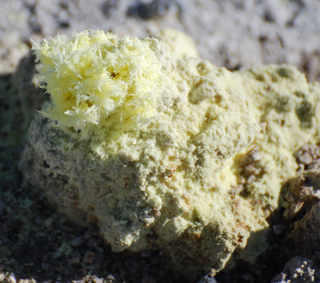 Beth in front of Porcelain Basin at Norris Geyser BasinOf all the wonders I’ve experienced in Yellowstone—listening to the musical howling of wolves, watching a bison give birth, or gazing at Old Faithful erupt in a burst of angry steam—nothing has amazed me more than the sights revealed during a recent hike through Norris Geyser Basin.
Beth in front of Porcelain Basin at Norris Geyser BasinOf all the wonders I’ve experienced in Yellowstone—listening to the musical howling of wolves, watching a bison give birth, or gazing at Old Faithful erupt in a burst of angry steam—nothing has amazed me more than the sights revealed during a recent hike through Norris Geyser Basin.
Part of the wonder was no doubt due to my guide, Mike Keller, who has been “geyser gazing” in Yellowstone since he began volunteering in the park at the age of 14. Mike currently works as the Executive Director of Operations for the park concessioner, but spends most of his free time wandering through Yellowstone studying geothermal features. As president of the Geyser Observation and Study My guide, "geyser gazer" Mike Keller Association, his enthusiasm for all things geothermal is contagious and his knowledge of geology is vast. When Downfall Geyser erupted during our hike to a level he had not previously witnessed, he could not contain his child-like glee.
My guide, "geyser gazer" Mike Keller Association, his enthusiasm for all things geothermal is contagious and his knowledge of geology is vast. When Downfall Geyser erupted during our hike to a level he had not previously witnessed, he could not contain his child-like glee.
Norris Geyser Basin is described in the NPS guide as “one of the hottest and most dynamic of Yellowstone’s hydrothermal areas.” But even this description is an understatement—the otherworldly nature of the area simply evokes awe. For the entire hike, I thought I had been transported to another planet. I was also very aware how fragile and thin the earth’s crust is in Yellowstone—the volcanic underworld lurks very close in the park, one of the largest geologic hotspots in the world.
 A crystal sulfur flowerWithin the basin, superheated beads of sulfur crackle as they rise to the surface and coalesce in Cinder Pool, a desolate, spooky hot spring that evokes images from Dante’s Inferno. Steamboat Geyser, the world’s tallest active geyser, frequently spouts out steam and minor eruptions of water an impressive 10-40 feet high, but its true power—water exploding more than 300 feet into the sky—has only been witnessed rarely (Steamboat last erupted in May of 2005). Echinus Geyser, the largest acidic geyser known to exist, displays red and orange hued deposits shaped like the spines of starfish. In the barren landscape, sulfur crystallizes and blooms into delicate yellow flowers and the mineral realgar paints a tree with red-orange hues.
A crystal sulfur flowerWithin the basin, superheated beads of sulfur crackle as they rise to the surface and coalesce in Cinder Pool, a desolate, spooky hot spring that evokes images from Dante’s Inferno. Steamboat Geyser, the world’s tallest active geyser, frequently spouts out steam and minor eruptions of water an impressive 10-40 feet high, but its true power—water exploding more than 300 feet into the sky—has only been witnessed rarely (Steamboat last erupted in May of 2005). Echinus Geyser, the largest acidic geyser known to exist, displays red and orange hued deposits shaped like the spines of starfish. In the barren landscape, sulfur crystallizes and blooms into delicate yellow flowers and the mineral realgar paints a tree with red-orange hues.
Here’s a selection of photos from my afternoon at Norris Geyser Basin. Visit my photo collections for the full set.
 The cerulean blue waters of Elk Geyser
The cerulean blue waters of Elk Geyser
 The crackling sulfur beads of Cinder Pool
The crackling sulfur beads of Cinder Pool Runoff with thermophiles from Whirligig Geyser
Runoff with thermophiles from Whirligig Geyser
